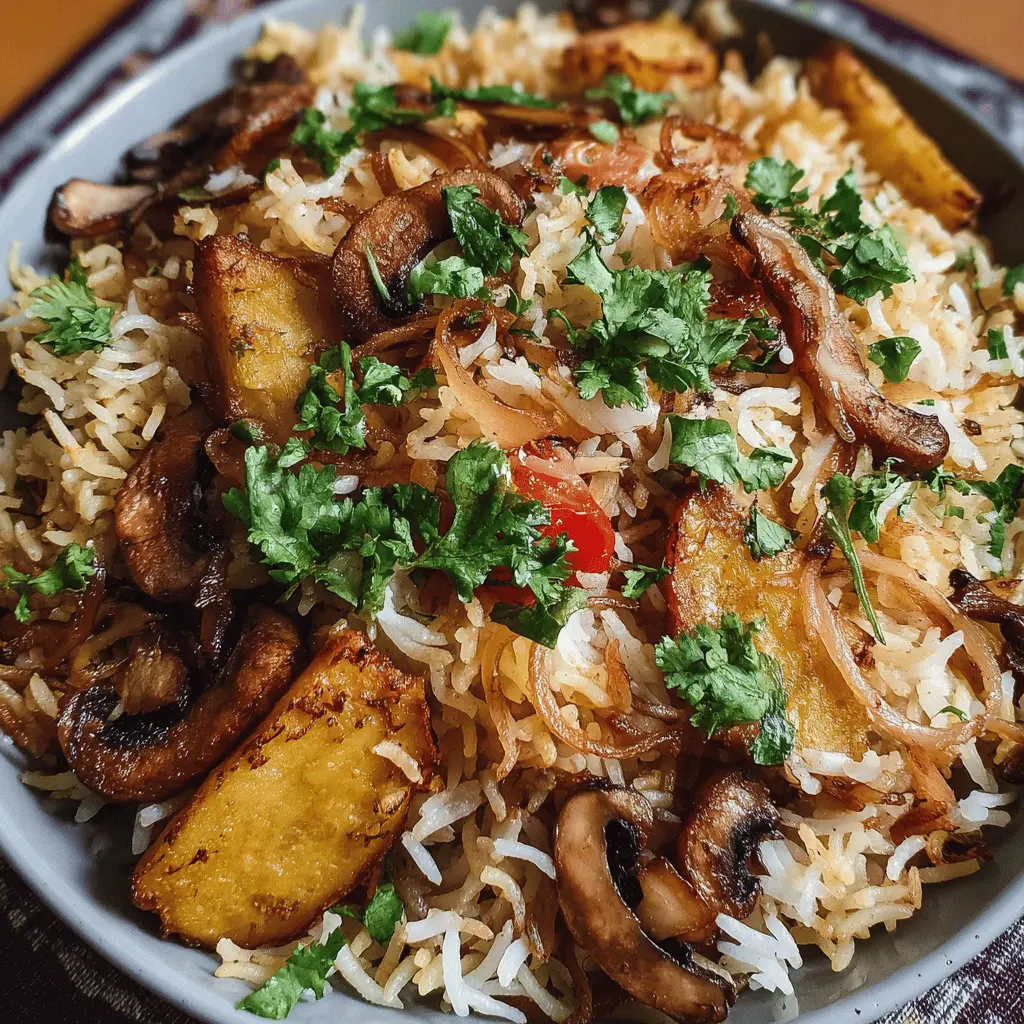Introduction to Vegetarian Biryani Rice
Vegetarian Biryani Rice is more than just a dish; it’s an experience that encapsulates vibrant flavors, rich aromas, and the warmth of home-cooked meals. If you’re new to this delightful creation, you might wonder what makes it stand out. At its core, biryani is a traditional Indian dish made of fragrant basmati rice, aromatic spices, and a medley of vegetables, making it perfect for vegetarians and anyone looking to reduce meat consumption.
What is Vegetarian Biryani Rice and why should you try it?
So why should you delve into making vegetarian biryani rice? For starters, it’s incredibly versatile. You can customize it with seasonal vegetables like carrots, peas, or bell peppers, bringing a delightful crunch and a pop of color to your plate. Whether you’re hosting friends for a dinner party or just want a cozy meal for yourself, biryani fits the bill perfectly.
-
Flavors and Spices: This dish is a symphony of spices. Ingredients like cardamom, cloves, cumin, and saffron elevate the natural flavors of the rice and veggies, offering a taste experience you won’t forget. If you’re keen on learning about these spices, check out The Spice House for some insights.
-
Nutritional Benefits: A bowl of vegetarian biryani isn’t just flavorful; it’s also nutritious. Rich in complex carbohydrates and packed with vitamins from various vegetables, it can be a fulfilling meal option. Adding protein sources like chickpeas or lentils makes it even more balanced.
-
Culinary Adventure: Cooking vegetarian biryani rice can be a fun project. There’s something therapeutic about layering flavors and aromas, especially when you realize that you have crafted something that not only fills your stomach but also soothes your soul.
If you haven’t yet explored the world of vegetarian biryani, this is your sign to dive in! Grab your ingredients and get ready to impress your taste buds. It’s time to celebrate the joys of cooking and savor the delightful experience that vegetarian biryani rice brings to your table.

Ingredients for Vegetarian Biryani Rice
Essential ingredients for a flavorful biryani
Creating a delightful vegetarian biryani rice starts with gathering fresh, aromatic ingredients. Here’s a list of essentials that will elevate your dish:
- Basmati Rice: Opt for long-grain basmati for its fragrant aroma and fluffy texture.
- Assorted Vegetables: Think vibrant bell peppers, carrots, peas, and potatoes.
- Onions and Garlic: Sautéed onions add sweetness, while garlic enhances the overall flavor.
- Spices: Garam masala, cumin seeds, and turmeric are non-negotiable in delivering that authentic taste.
- Herbs: Fresh cilantro and mint leaves impart an irresistible freshness.
Optional ingredients for added flavor
Feeling adventurous? You can include some optional ingredients that truly personalize your vegetarian biryani rice:
- Nuts and Dried Fruits: Cashews and raisins add a lovely crunch and sweetness.
- Paneer or Tofu: For extra protein and creaminess, add cubes of paneer or marinated tofu.
- Saffron or Food Coloring: A pinch of saffron can lend a royal touch, or use food coloring for a festive appearance.
With these ingredients in hand, you’re well on your way to crafting a mouthwatering biryani that will impress anyone at the dinner table. If you’re unsure about how to prepare your ingredients or need cooking tips, check out this comprehensive guide on rice preparation. Happy cooking!
Step-by-step Preparation of Vegetarian Biryani Rice
Making vegetarian biryani rice is a delightful culinary journey that can transform your ordinary weeknight dinner into a fragrant feast. This step-by-step guide will lead you through each part of the process, ensuring you create a dish that’s not only scrumptious but also full of wholesome nutrients. Let’s dive in!
Gather and Prepare Your Ingredients
Before you begin cooking, it’s crucial to have everything ready to go. This not only streamlines the cooking process but also makes it much more enjoyable. Here are the key ingredients you’ll need:
- Rice: Use Basmati rice for its fragrant aroma and fluffy texture.
- Vegetables: Carrots, peas, bell peppers, and green beans are great choices.
- Spices: Cumin, cardamom, cloves, and cinnamon sticks will elevate the flavor.
- Aromatics: Garlic, ginger, and onion add depth to the dish.
- Herbs: Fresh cilantro and mint will bring brightness.
- Stock: Substitute red or vegetable stock for added flavor instead of water.
Feel free to customize this list based on what you have handy. Perhaps you’re a fan of mushrooms or zucchini—add those in! Planning ahead ensures you won’t scramble to find an ingredient right when you’re about to cook.
Sauté the Spices and Aromatics
Once your ingredients are prepped, it’s time to awaken your kitchen with some aroma!
- In a large pan, heat some oil (coconut or vegetable oil works well) over medium heat.
- Add whole spices like cumin seeds, cloves, and cardamom pods, letting them sizzle for about a minute until they start to release their fragrant oils.
- Toss in finely chopped onions and sauté until they turn golden brown, usually around 5-7 minutes.
- Add minced garlic and ginger, cooking for an additional 1-2 minutes.
This step is where things get aromatic—don’t skip it! The depth of flavor from sautéing the spices and aromatics sets the foundation for your vegetarian biryani rice.
Add the Vegetables for a Wholesome Meal
Now that you have your aromatic base, it’s time to layer in the colorful veggies.
- Add your chosen vegetables (carrots, peas, bell peppers, and green beans) in the pan.
- Sauté for 5-7 minutes, stirring occasionally until they’re slightly tender but still vibrant.
Vegetables not only provide essential nutrients but also bring texture and flavor. Don’t hesitate to experiment with seasonal produce! Want to make it a bit spicy? Throw in some chopped green chilies at this stage.
Combine with Rice and Cook to Perfection
Now, let’s unite all these beautiful flavors!
- Add the soaked and drained Basmati rice to the pan, stirring it gently into the mix of veggies and spices to coat the grains.
- Pour in your vegetable stock or water, season with salt, and bring to a boil.
- Lower the heat, cover the pan, and let it simmer for about 15-20 minutes.
During this time, you’ll want to resist the urge to lift the lid. The steam works its magic, cooking the rice to perfection. Once it’s done, turn off the heat and let it sit, covered, for an additional 5 minutes.
Garnish and Serve Your Delicious Biryani
Finally, it’s time for the grand reveal! Fluff the rice gently with a fork to separate the grains, and serve it up.
- Garnish with fresh cilantro and mint for an extra burst of freshness.
- Consider pairing it with a yogurt raita or a fresh salad to complete the meal.
Invite friends over, or enjoy this vegetarian biryani rice solo with a good movie. Whatever you decide, you’ll be savoring the fruits of your labor. Bon appétit!
For more tips on cooking rice perfectly or additional recipes, check out resources like The Kitchn or Serious Eats. Happy cooking!

Variations on Vegetarian Biryani Rice
If you’re looking to expand your vegetarian biryani rice repertoire, you’re in for a treat. Here are three flavorful variations that’ll excite your taste buds and elevate your dining experience.
Spicy Paneer Biryani
For a creamy and spicy twist, try Spicy Paneer Biryani. The addition of paneer offers a rich texture and a flavor that balances beautifully with the spices. To make this dish:
- Sauté onions, garlic, and ginger in a pan.
- Mix in diced paneer, green chilies, and your selection of spices like garam masala and turmeric.
- Combine this mixture with pre-cooked rice, adding fresh coriander for a pop of freshness.
This youthful take on biryani is perfect for those who enjoy a little heat!
Mixed Vegetable Biryani
Want to pack in some nutrients? Go for the Mixed Vegetable Biryani. Not only is this variation vibrant, but it also allows you to utilize whatever veggies are lying in your fridge. Here’s how to whip it up:
- Collect a mix of seasonal vegetables, such as carrots, peas, and bell peppers.
- Sauté them with spices and add them to your rice.
This recipe is versatile, and you can check out this article on seasonal eating for more ideas on what veggies to incorporate.
Coconut Biryani
For a tropical flair, Coconut Biryani offers a unique approach. The use of coconut milk or grated coconut gives the rice a delightful creaminess. To prepare this dish:
- Cook your rice with coconut milk and spices like cinnamon and cardamom.
- Add in veggies or nuts for an added crunch.
This biryani is a lovely change of pace and serves as a fantastic accompaniment to a summer meal.
These variations not only make for a delectably different dish but can also cater to any gathering, making every mealtime a celebration!
Cooking Tips and Notes for Vegetarian Biryani Rice
Key Techniques for Perfecting Your Biryani
To create vegetarian biryani rice that impresses, focus on the layering of spices and ingredients. Start with a good quality basmati rice, which absorbs flavor beautifully. Rinse the rice until the water runs clear to remove excess starch, ensuring each grain stays separate during cooking. Infuse your dish with whole spices like cardamom and cinnamon, adding them to hot oil to release their fragrances before adding vegetables. Layering is crucial; alternate between rice and your vegetable mix for even distribution of flavors.
For more on the art of blending spices, check out this guide on Indian spices.
Common Pitfalls to Avoid
One common mistake is overcooking the rice, leading to mushiness. It’s best to cook the rice only until it’s 70% done before layering. Avoid overcrowding the pot; if you’re making a large batch, consider cooking in two separate pots. Lastly, remember to allow your vegetarian biryani rice to rest after cooking; this helps meld the flavors beautifully. Proper storage and reheating can also elevate your dish for another meal, so learn the best practices for this here.

Serving Suggestions for Vegetarian Biryani Rice
Pairing Your Biryani with Sides for a Complete Meal
When enjoying vegetarian biryani rice, pairing it with the right sides can elevate your dining experience. Consider serving it with:
- Raita: A cooling yogurt sauce mixed with cucumber and mint. It’s the perfect counterbalance to the spices in biryani.
- Pickles: Indian pickles, or achar, add a zingy flavor that complements the rice beautifully.
- Papadam: Crisp and savory, these lentil crackers add a delightful crunch.
- Salad: A simple cucumber and tomato salad dressed with lemon juice can freshen up your plate.
These additions not only enhance the flavors but also provide a balanced meal that’s nourishing and satisfying.
Creative Ways to Enjoy Leftovers
Leftover vegetarian biryani rice doesn’t have to be mundane. Try these fun ideas to revitalize your leftovers:
- Biryani Bowl: Mix the rice with sautéed vegetables and a drizzle of soy sauce for a stir-fry twist.
- Stuffed Peppers: Fill bell peppers with the leftover rice mixture, top with cheese, and bake for a hearty meal.
- Crispy Biryani Cakes: Form the rice into patties, pan-fry until golden, and serve with chutney.
With these suggestions, your vegetarian biryani rice can wow your taste buds all over again!
For more tips on Indian cooking, check out Indian Cooking Techniques or explore amazing side dish recipes on BBC Good Food.
Time Breakdown for Vegetarian Biryani Rice
When you’re excited to whip up a delicious vegetarian biryani rice, knowing the time you’ll need is essential. Here’s how the timing breaks down:
Preparation Time
Setting aside around 15-20 minutes for preparation is key. This includes washing and soaking the rice as well as chopping your favorite veggies. This step is vital to ensure the flavors of your biryani meld perfectly.
Cooking Time
Once you’re ready to cook, expect about 30-40 minutes on the stove. Keep an eye on your spices and the steaming process to achieve that perfect aroma.
Total Time
In total, you’ll spend about 50-60 minutes to enjoy your flavorful vegetarian biryani rice. This time investment lets you savor an exquisite meal that’s worth every minute spent in the kitchen!
For more tips on making your biryani stand out, check out sources like BBC Good Food for flavorful inspiration.
Nutritional Facts for Vegetarian Biryani Rice
When diving into the delicious world of vegetarian biryani rice, it’s essential to appreciate its nutritional profile. This vibrant dish is not only flavorful but also packs a solid nutritional punch!
Calories
A standard serving of vegetarian biryani rice contains about 250-350 calories, making it a hearty yet wholesome option for lunch or dinner. When you’re busy, this dish is filling enough to keep you satisfied without weighing you down.
Protein
Protein lovers will appreciate that vegetarian biryani rice can provide around 8-12 grams of protein per serving. This is largely due to the rich assortment of vegetables and legumes used, which are vital components in any balanced diet. You can also add plant-based proteins like chickpeas for an extra boost!
Dietary Fiber
One of the standout features of vegetarian biryani rice is its fiber content. A serving typically boasts around 3-5 grams of dietary fiber, which aids digestion and keeps you feeling full longer. A fiber-rich diet is linked to numerous health benefits, including a lowered risk of chronic diseases.
For more insights on healthy eating, check out Healthline or Nutrition.org to explore the numerous advantages of including high-fiber foods in your meals.
Eating vegetarian biryani rice not only satiates your taste buds but also keeps your body nourished, ensuring you have the energy to tackle your busy day!
FAQs about Vegetarian Biryani Rice
Can I make vegetarian biryani rice in advance?
Absolutely! Vegetarian biryani rice is perfect for meal prep. You can cook it a day ahead and store it in the fridge. When you’re ready to enjoy it, simply reheat in a pan or microwave. Just remember to add a splash of water before reheating to keep it moist and flavorful. If you’re looking for tips on storing, check out this great guide on meal prep.
What are the best substitutes for basmati rice?
While basmati rice is a classic choice for vegetarian biryani rice, there are some fantastic alternatives. Consider using:
- Jasmine rice: Slightly stickier and fragrant, it makes a delicious substitute.
- Long-grain rice: This is a versatile option that adapts well to spices.
- Brown rice: A healthier twist, though it requires a longer cooking time.
Don’t forget, each type of rice has its unique texture, which can subtly change the dish’s flavor.
How can I make biryani spicier?
Want to add a kick to your vegetarian biryani rice? Start by tweaking the spices during cooking. Here are a few tips:
- Add more green chilies: Spice it up with finely chopped green chilies for an instant heat boost.
- Use red chili powder: A teaspoon or two can dramatically change the flavor profile.
- Incorporate fresh ginger and garlic: These options not only add spice but also layers of flavor.
Experiment with these suggestions, and you might just discover a combination that you love! For more insights on spice levels, check out this resource on balancing spice in dishes. Enjoy the journey of creating your perfect vegetarian biryani rice!
Conclusion on Vegetarian Biryani Rice
Why vegetarian biryani should be a staple in your kitchen
Incorporating vegetarian biryani rice into your meal rotation offers a delightful way to enjoy bold flavors and wholesome ingredients while catering to various dietary preferences. This dish is perfect for anyone seeking a hearty, nutritious meal without the meat.
Here’s why you should make it a staple:
- Health Benefits: Packed with vegetables, spices, and whole grains, it provides essential nutrients and fiber.
- Versatility: Customize it with your favorite veggies or protein substitutes like chickpeas for added nutrition.
- Quick and Easy: Ideal for busy weeknights, vegetarian biryani rice can be prepared in under an hour.
By embracing this vibrant dish, you not only expand your culinary skills but also join a flavorful journey that elevates vegetarian dining. Discover more about veggie-rich diets here and why they’re gaining popularity!
PrintVegetarian Biryani Rice: A Flavorful and Easy Homemade Delight
A rich and aromatic Vegetarian Biryani Rice that brings together a medley of veggies and spices for a fulfilling meal.
- Prep Time: 15 minutes
- Cook Time: 30 minutes
- Total Time: 45 minutes
- Yield: 4 servings 1x
- Category: Main Course
- Method: Stovetop
- Cuisine: Indian
- Diet: Vegetarian
Ingredients
- 2 cups basmati rice
- 1 cup mixed vegetables (carrots, peas, bell peppers)
- 1 onion, sliced
- 3 cloves garlic, minced
- 1 tablespoon ginger, grated
- 2 tablespoons biryani spice mix
- 4 cups vegetable broth
- 2 tablespoons cooking oil
- 1/4 cup cilantro, chopped
- 1/4 cup mint leaves, chopped
- Salt to taste
Instructions
- Heat oil in a large pot over medium heat. Add onions and sauté until translucent.
- Stir in garlic and ginger, cooking for an additional minute.
- Add mixed vegetables and biryani spice mix, stirring well.
- Pour in the vegetable broth and bring to a boil.
- Add basmati rice, cover, and reduce heat to low. Cook for 15-20 minutes, or until rice is done.
- Fluff the rice with a fork, and stir in chopped cilantro and mint before serving.
Notes
- For a spicier version, add chopped green chilies.
- Fresh herbs enhance flavor – don’t skip the cilantro and mint!
Nutrition
- Serving Size: 1 cup
- Calories: 250
- Sugar: 3g
- Sodium: 400mg
- Fat: 7g
- Saturated Fat: 1g
- Unsaturated Fat: 5g
- Trans Fat: 0g
- Carbohydrates: 40g
- Fiber: 4g
- Protein: 6g
- Cholesterol: 0mg
Keywords: Vegetarian Biryani Rice, Biryani, Vegetarian Recipes, Rice Dishes












